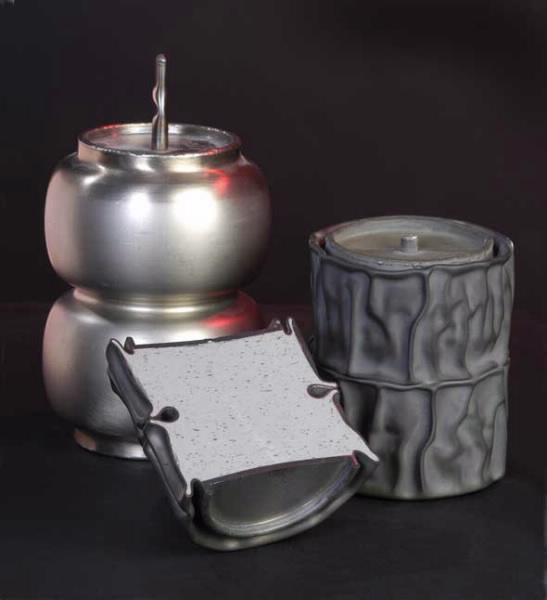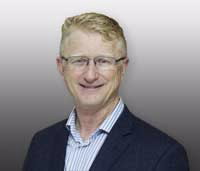Synroc, an Australian innovation to store nuclear waste, has moved to apply its research knowledge into a detailed engineering project that will see it deliver a fully integrated processing plant to treat the liquid by-product stream from the manufacture of molybdenum-99 (Mo-99).
 |
| A thin-walled vessel ( back left) is filled with a granulated waste form powder that is subsequently compressed into a solid mass by hot isostatic pressing . The can is designed to collapse into a cylindrical shaped vessel (right) for storage. The centre image shows a cross-section of the dense solid waste form that is encapsulated within the thin-wall vessel. |
Synroc mimics the natural ability of rocks to lock up radioactive elements for hundreds of millions of years. As a waste form Synroc also reduces the storage volume of by-products significantly when compared to other disposition methods, such as glass and cement technologies.
The development of the Synroc manufacturing facility was funded by the Federal Government as part of the ANSTO Nuclear Medicine (ANM) project.
With funding and approval from an independent nuclear regulator, things are moving ahead at ANSTO Synroc.
“We’re in the engineering phase, seeking to further develop our process intellectual property on Synroc and move it to an industrial scale demonstration of our technology,” explained Gerry Triani, Synroc Technical Director (below right). “Synroc is moving to realise its design concept into a fully functional process plant that will treat intermediate level waste from the ANSTO Nuclear Medicine project.”
 |
Today Synroc combines both the waste form design and process technology, which gives it distinct advantages allowing it to be tailored to the specific nuclear waste to be immobilised.
The story of Synroc began in 1979, when it was invented by an Australian National University researcher, the late Prof Ted Ringwood and scientists at ANSTO, as a synthetic waste form to immobilise the by-products of nuclear reactions.
“In the nuclear industry, timelines for decisions to treat waste are particularly long, relying on the premise that radioactive waste decays,” said Triani. “Synroc has been funded to support the expansion of Mo-99 at ANSTO thereby giving our technology a great opportunity to move from a design concept to an industrial scale waste treatment plant.”
ANSTO is building a large scale operational waste treatment plant with a capacity to satisfy the ANM facility which is now under construction. Current nuclear medicine production of 550,000 doses of Mo-99 a year could triple, when the new facility is fully operational.
Mo-99 is a radioisotope that is widely used in the diagnosis of cancer, cardiac conditions and skeletal injuries. It is estimated one in two Australians will benefit from the nuclear medicines that originate from ANSTO.
“In our demonstration facility we are building a fully integrated pilot plant that will replicate the liquid waste being converted to a free-flowing powder, which will form the design inputs for the final plant,” said Triani. The pilot plant is expected to be operational mid-2016.
“Many countries have expressed an interest in the Synroc technology, so this first of a kind plant that will treat waste from molybdenum-99 will attract a lot of attention from producers,” added Triani.
“With a demonstration of the Synroc technology at the backend of the Mo-99 production process, this technology will close the Mo-99 production cycle by permanently dealing with the waste that is generated. Hopefully this technology will become the benchmark for waste treatment in the production of Mo-99 radiopharmaceuticals,” said Triani.
Synroc is a complete package, and that gives it distinct advantages over other waste forms. Testing has shown that our waste form exceeds international benchmarks for leaching of radionuclides—a critical requirement for storage and disposal in the nuclear industry.
“Also, Synroc technology can significantly reduce the volume of the liquid waste stream, thereby reducing storage costs,” said Triani.
In the first part of the Synroc process, the radioactive liquid is mixed with additives that create a slurry that is then dried to produce a free-flowing powder. The granular powder is thermally treated before it is accurately dispensed into cans where it is sealed. The can is placed inside a furnace that is contained within a hot isostatic press, where heat and pressure are applied to lock in the radionuclides. Under these conditions the powdered mixture fuses together to form a solid without releasing any emissions. The can contracts to form a cylindrical shape which is designed for storage efficiency.
“After working with smaller models in our development, we’re at the stage of up-scaling the can to its final size and shape, thereby demonstrating the HIP process on our wasteform at the engineering scale required for the waste treatment plant,” said Triani.
“By increasing our technology readiness levels of the process in our demonstration plant, we are essentially de-risking many of engineering challenges for the waste treatmentplant design going forward.”
Working with smaller volumes at the research scale can be relatively straight forward; however, the Synroc team has now demonstrated industrial scale processes that can translate into processing thousands of litres of liquid waste per year.
“The front-end of the production process has a cascade flow producing a continuous stream of powder. We have designed an integrated system that will regulate that flow to ensure there is limited inventory of powder with the facility. This powder will be dispensed accurately into the can during this stage of production,” he said.
The HIP technology is key to our production process. ”But it is also a rate limiting step in terms of its batch mode processing,” explained Triani. “This has necessitated some clever process engineering to synchronise powder feed rate to the back-end HIP process cycle time.“
“Another engineering challenge is to take the entire process and design it to work remotely in a hot cell about 800 millimetres thick that acts as shielded enclosure,” explained Triani. Shielding is necessary to protect operators and maintenance staff, so the hot cell needs numerous special design features to ensure equipment can operate and be maintained.
“The guiding principle is to keep the design simple to ensure our plant operates reliably, using gravity to deliver material to the next process and to ensure that all equipment is configured as modular systems that are easy to maintain,” said Triani.
Triani is particularly proud that the Synroc team is meeting all of the engineering challenges. We have assembled a new team based on a mix of experience and youth that has rejuvenated the atmosphere within our group. We have a balance between skilled and dedicated Synroc technical and professional staff—together with an injection of talented engineers”, said Triani.
The Synroc team is organised into disciplines covering wasteform engineering , a process engineering groups for the front and back end of production plus a governance group.
“The next key milestone in the short-term is to create a fully integrated process of our front-end in our demonstration plant. We will fill a can using a cascade delivery system to demonstrate the processes as they need to be configured in a hot-cell. The can will then be sealed before transporting it to our current large HIP facility” said Triani.
Construction of the new waste treatment plant is expected to commence later this year. The treated waste will be stored at ANSTO.
*****
A look at some of the members of the Synroc Team
 |
| (left to right) Alejandra Siverio Gonzales, Rohan Holmes, Catherine Cheung, Dorji Chavara, and Dan Gregg |
Catherine Cheung is a Nuclear Waste Form Process Engineer. She has a PhD in Chemical Engineering, Bachelor of Chemical Engineering and Bachelor of Commerce. She joined the Synroc team from the ANSTO graduate program in 2011. Her current role in ANSTO Synroc includes up-scaling chemical processes, conducting analyses and translating important findings before making technical recommendations for detailed engineering design. In particular, Catherine has focused on the rheology of the liquid compositions of the Synroc waste treatment process in order to ensure materials can be readily processed. “It is probably any engineer's dream to work through a 'proof of concept' to a full scale industrial process. That's what we do in Synroc, we offer treatment solutions to challenging nuclear waste streams,” said Cheung.
Dan Gregg is a Nuclear Wasteform Engineer and materials scientist with a PhD in Chemistry from Trinity College Dublin. He is also a lecturer in nuclear engineering at UNSW. He joined the Institute of Materials Engineering in 2010 to investigate new materials for application in the nuclear fuel cycle. Undertaking research and development into ceramic materials for the immobilisation of nuclear waste and transmutation matrices, particularly in the fabrication and characterisation of uranium, thorium and plutonium-doped oxide materials, his work provides scientific support allowing a deeper understanding of waste form compositions. “It’s a privilege to work closely with Synroc’s Chief Research Scientist Lou Vance,” said Gregg. In 2014 Dan joined the Synroc project to provide design support in the development of a resilient wasteform for the Synroc waste treatment plant. In 2015 he became leader of the Synroc wasteform engineering team, which is also undertaking major international collaborative projects demonstrating the applicability to challenging nuclear waste streams.
Alejandra Siverio Gonzales is a Chemical Process Engineer who has been working for Synroc for approximately four years. She is an enabler who produces design specifications from test and inspection plans ensuring that results and processes are scalable for design and construction. Alejandra has a background in the oil and gas industry. “Working for Synroc in a development environment for the nuclear industry has been a challenge but it has also been a privilege to work alongside an outstanding group of scientists, technicians and engineers,” said Siverio Gonzales. She expects Synroc technology to transform the way nuclear waste is managed worldwide which represents a significant accomplishment for ANSTO.
Dorji Chavara is a Nuclear Materials Process Engineer with ANSTO Synroc who leads the back-end process engineering team which is focused on the development of key technologies, remote powder filling of cans and HIP processing for the immobilisation of nuclear waste.
After completing a PhD in Engineering at the University of Sydney, Dorji joined ANSTO in 2009 as a Postdoctoral Fellow to focus on the development of material solutions in extreme environments. After a three year hiatus in engineering consultancy, he returned to ANSTO as a Nuclear Materials Engineer. With both a research interest and comprehensive experience in powder handling and processing, he leads the Hot Isostatic Pressing (HIP), can development (optimised and tailored for specific waste streams), and can filling/sealing. “It’s a once in a life time opportunity to develop engineering concepts into a fully functional process,” said Chavara.
Dr Rohan Holmes is a nuclear process engineer within ANSTO Synroc. He holds a Bachelor of Chemical Engineering and a Masters of Biomedical Engineering from the University of New South Wales. He is responsible for overseeing the front-end integration of the Synroc process and works at the interface between Synroc personnel and engineering and capital program staff tasked with building the Synroc plant. Rohan is responsible for overseeing the demonstration and integration of process technologies which convert the liquid streams into powder and the subsequent thermal processing steps. Rohan is also leading the development of a pilot plant within the Synroc demonstration facility for the validation of the process technologies. He has an extensive knowledge of processing and characterisation of materials ranging from soft matter, such as polymers and plastics through to hard matter, such as ceramics and alloys
Published: 18/02/2016


